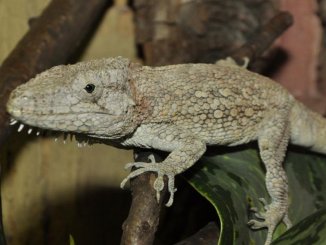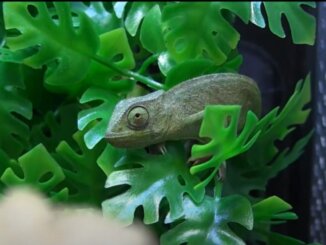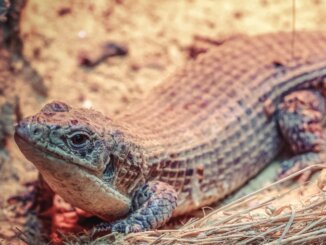The draco lizard is a flat-bodied lizard species with wing-like lateral extensions that enable it to glide from one tree to another. The lizard has a mottled brown color that serves as camouflage against tree bark. The draco lizard is endemic to Southeast Asia, particularly the Philippines, Borneo, and the southern part of India.
Draco lizards are abundant across their natural habitat. They aren’t readily available in pet stores and are expensive, but some people still keep the lizards as pets. Keeping draco lizards as pets is difficult since they are challenging to feed and breed, and require special arboreal enclosures.
Draco Lizard Overview
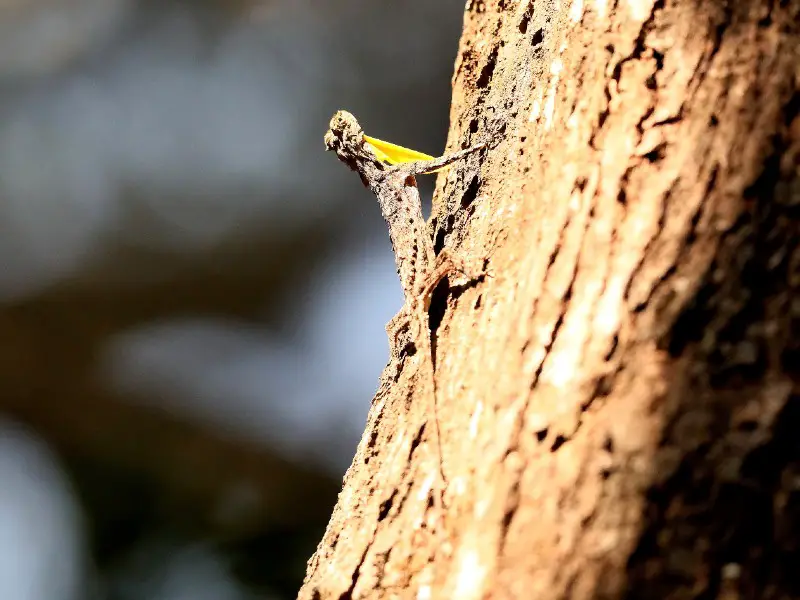
| Common name | Flying lizards |
| Scientific name | Draco volans |
| Natural habitat | Tropical rainforests of Southern Asia in the Philippines, Borneo, and Southern part of India |
| Adult size | 8 inches |
| Average lifespan | Eight years |
| Diet | Insectivorous |
| Housing | Glass Aquariums and PVC enclosures |
| Experience level | Expert |
Origin
Draco lizards (Draco volans) are endemic to the Philippines, Borneo in Southern Asia, and the Southern part of India. Draco lizards inhabit tropical rainforests and densely wooded areas that provide excellent perching and basking spots. The lizards are arboreal, which means they spend their lives living in trees.
Draco lizards are common in their natural habitats and are not classified as endangered or protected. Their flying ability separates them from other lizards, making draco lizards unique and fun to watch.
Appearance and Behavior
Draco lizards feature flattened bodies and extended ribs that retract and extend when gliding. A membrane that holds the ribs in place stretches from behind their front legs to their back legs. The lizards are mottled brown, but red, blue, and yellow variations exist in some draco species.
Male draco lizards have wings that are blueish and brown on the dorsal side. Males also feature pointed dewlaps that are bright yellow and project from their throats. Females have bluish to gray dewlaps and feature yellow coloration on their ventral side.
Draco lizards are diurnal species, which means they are active during the day and sleep at night. Lizards spend their time perched on trees and will glide from tree to tree when they need to move. When draco lizards face danger, they will crawl up the tree trunk to escape. These lizards won’t glide when there’s rain or strong wind.
Size and Lifespan
Draco lizards are, on average, eight inches long. Their tails make up more than half their length, measuring over four inches long. Males are shorter than females. Draco lizards weigh between 0.73 to four ounces. Females are also heavier than males.
Male and female draco lizards have an average lifespan of eight years. Lizards living in well-kept captive environments can live up to 10 years. Providing the lizards with perching spots and sense stimulation will help increase their lifespan.
Temperament
Draco lizards are territorial. Males will defend their territory at all costs. They will glide from tree to tree as they chase other males. Males use intimidation displays such as flashing their dewlaps to scare away their competitors. A single male draco lizard will dominate about one to three females occupying up to three trees.
Keeping multiple draco lizards in the same environment will lead to fights between the lizards, usually ending in serious injuries. Ensure the lizards are kept separately and only allow interaction between lizards during breeding.
Draco lizards are skittish, and handling is challenging for beginners. Lizards will bite as part of their defense mechanism, so wear gloves or protective clothing when handling. Their bites are painful but not dangerous. Handle the lizard with care. You should support the lizard’s body with your hands. Keep one under the front and the other under the hind limbs. The draco lizard is fragile and will break a bone easily if mishandled.
Housing Draco Lizards
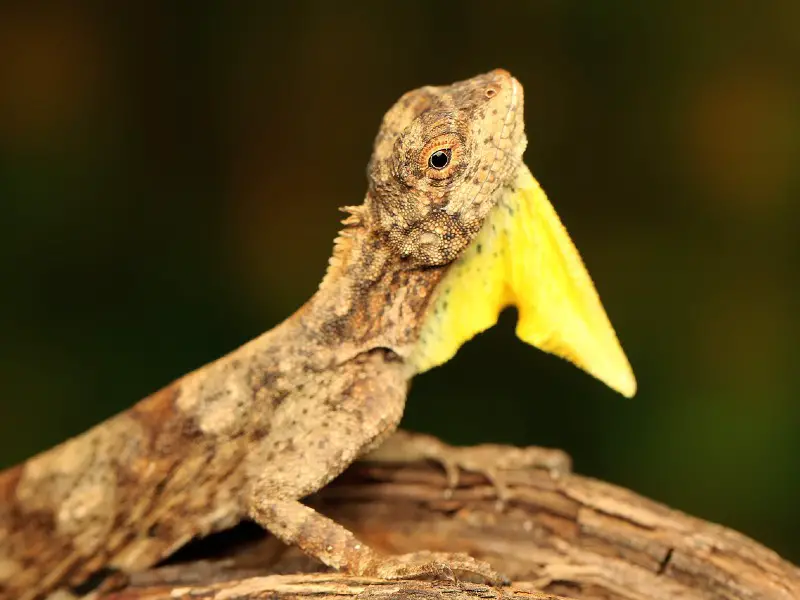
Mimicking the natural environment of draco lizards will provide them with better development and more opportunities to display their natural behavior. Glass aquariums and PVC enclosures make excellent housing for draco lizards.
Adding a screen top to the enclosure will allow ventilation and prevent your lizards from escaping. A tall enough enclosure provides draco lizards enough surface area to launch into flight.
Draco lizards live in tropical rainforest trees and low altitudes. The lizards are arboreal, which means they prefer to spend their time on trees and thrive in temperatures of about 80 degrees Fahrenheit.
Enclosure size
Draco lizard enclosures should measure 30 inches high, 16 inches long, and 16 inches wide. A large tank is better for this species as it gives the lizard ample gliding space..
Lighting
Intense UV lights are great for draco lizard enclosures. Reptisun 10.0 t5 high output bulbs provide consistent UV rays throughout the enclosure and help the lizard properly develop its bones and muscles. An additional fluorescent bulb placed above the enclosure can help promote further plant growth.
Temperature and Humidity
Draco lizards are tropical species, so temperature plays a vital role in their development. The ideal temperature for these lizards is between 70 and 80 degrees Fahrenheit. Different parts of the enclosure should have different temperatures.
Provide draco lizards with basking temperatures of about 80 to 90 degrees Fahrenheit, and let the enclosure cool down to 70 degrees Fahrenheit at night. A heating bulb will help provide a thermal gradient in the enclosure. Hand warmers may also help provide additional heat for the enclosure.
The ideal humidity level for the enclosure is 75% to 85%. An automatic misting system will help acclimate the humidity levels, giving the lizard the required hydration. Use a hygrometer to monitor the humidity levels and a thermometer to monitor the temperature inside the enclosure.
Extreme temperatures can cause premature skin shedding and other health problems. Temperature regulation is necessary to keep the draco lizard healthy.
Substrate and Decoration
Draco lizards spend little to no time on the ground, so it’s essential to use an enclosure substrate that is easy to clean. Coco fiber moss and eco earth make reliable substrates for draco lizards. A drainage layer at the bottom of the enclosure helps prevent mold.
Adding plants and vines to the enclosure enhances its look while also providing additional climbing spaces. Tree branches and hollowed logs offer perching spots. Providing a variety of textures and surfaces will enhance the draco lizard’s development.
Draco lizards need special basking spots that reach high temperatures. A large rock, flat stone, or another type of rock formation can be used to construct basking spots.
Cleaning
Cleaning and maintaining the draco lizard’s enclosure is necessary to ensure the lizard’s well-being. Remove feces and uneaten food from the enclosure daily. Wipe the inside of the enclosure with a wet cloth to remove dirt or debris. Use ultraviolet light to inspect the draco lizard and the interior of the enclosure for parasites.
Draco Lizard Care
Caring for draco lizards is a serious commitment. New hobbyists will find it challenging keeping draco lizards. The lizards are delicate and require close attention to survive. Experts and professionals with previous experience can keep draco lizards. Keeping these lizards hydrated is the most critical part of their care. Proper hydration involves misting the enclosure every day.
Food and Water
Draco lizards are insectivorous. They feed on adult crickets, bean beetles, and fruit flies. Draco lizards have small heads so that they will eat smaller-sized insects. Dust the insects with calcium and vitamin powder to provide additional nutrients.
Feed draco lizards at least twice after every day, 3-4 times a week. Avoid feeding draco lizards, ticks, millipedes, scorpions, and fireflies. Some insects, such as fireflies, contain self-defense toxic chemicals deadly to reptiles.
Handling
Draco lizards are fragile and delicate. The lizards do not like being handled and will bite their handler or try to escape. The presence of predator animals can cause stress and will inhibit development. Avoid keeping draco lizards with other reptiles as this will cause stress. Other causes of stress include loud and shrill noises, high traffic areas, and other animals in the vicinity.
Draco lizards will lose appetite, hide, and become slow when stressed. Prolonged soaking and gradual behavior changes also indicate stress.
Common Health Issues
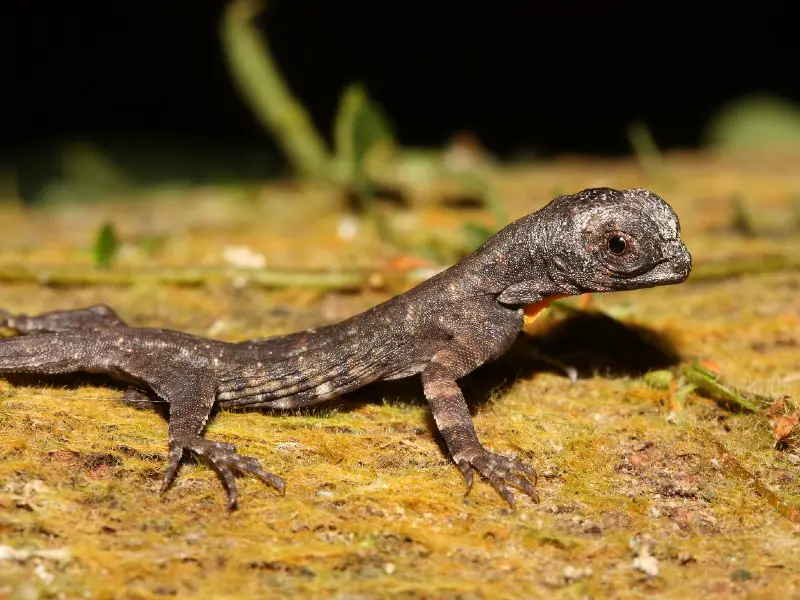
Draco lizards are challenging to take care of due to their delicate nature. Common health issues include poxvirus, metabolic bone disorders, and fungal infections.
Poxvirus is a common problem for draco lizards and other reptiles that affects their liver, kidney, and spleen. The virus appears as skin lesions and brown bumps on their eyes and mouth. Poxvirus is often fatal, so prevention is the best option. Avoiding close contact with other reptiles and ensuring optimum conditions is imperative.
Metabolic bone disorders (MBD) are caused by a lack of calcium, phosphorus, vitamin D3, and proper lighting. MBD weakens bones and causes stunted growth. Newborn draco lizards are most susceptible to MBD because they eat soft-bodied insects, including ants with no hard exoskeleton.
Providing adequate UV-A and UV-B lighting can help reverse the effects of MBD if detected early. Proper calcium and phosphorus supplementation are necessary to prevent MBD.
Fungal infections appear as white, cottony growths on the skin and body. Weight loss, lack of appetite, swelling, blisters, and itching are symptoms of fungal infections. Antifungal treatments such as itraconazole and ketoconazole will help cure fungal problems.
Breeding
Breeding draco lizards is challenging. The mortality rate in hatchling draco lizards is high. The first step in breeding draco lizards is to ensure they acclimate well to their enclosures.
To initiate the breeding process, provide draco lizards with a warm, humid hiding place to court. Maintain enclosure temperatures at about 80 degrees Fahrenheit for two weeks.
Introduce the male draco lizard to the female enclosure or vice versa. Keep the male and the female together for four days. The male will climb on the female’s back during mating, and the process will take 3-18 minutes.
Remove the male from the enclosure after four days while the eggs develop. Feed the female draco lizard calcium-rich insects such as crickets and mealworms. The female will start ballooning as the eggs develop inside her body.
Maintain the temperature at about 78 degrees Fahrenheit for the eggs to develop correctly. Ensure the temperature remains at this level from conception to hatching. Keep the humidity between 60-70%.
The female will lay her eggs four to six weeks after mating. The female will create a nest at the bottom of the tank and cover the eggs with soil, plant material, and peat moss. Incubate the eggs within 77-79 degrees Fahrenheit for 45 days.
The eggs will hatch within 45 days. Hatchling draco lizards are very delicate and require low humidity, high temperatures to survive. Keep hatchling draco lizards in a plastic box with holes to ensure the best result and feed them soft-bodied insects such as flies and termites.
Choosing and Buying a Draco Lizard
Draco lizards cost $39.99-$49.99 for hatchlings, and $60.99-$200 for adult draco lizards. These lizards are not readily available since breeding them in captivity is difficult. Some reputable breeders and pet stores sell draco lizards online.
Keeping draco lizards is tempting, but 99% of draco lizards die within their first days of captivity. These are delicate lizards that will dehydrate easily. There aren’t any restrictions for importing draco lizards. Hobbyists must ensure they have the right equipment to care for draco lizards before purchase.

